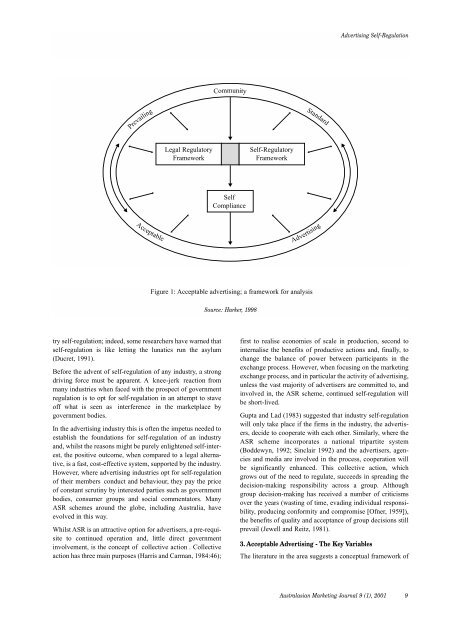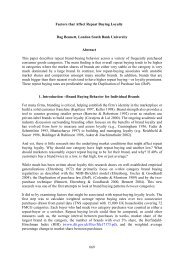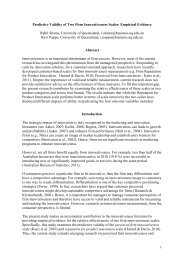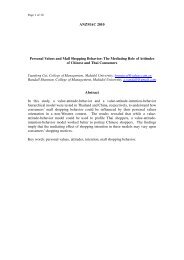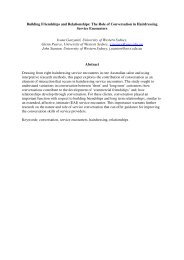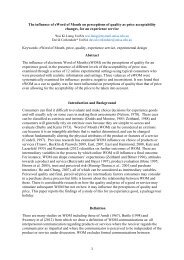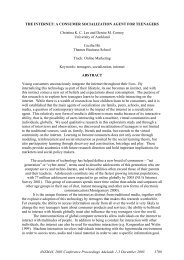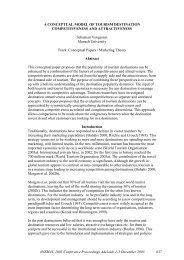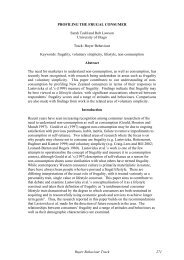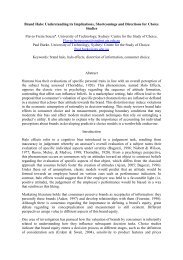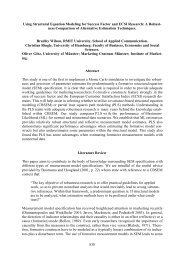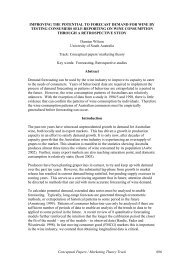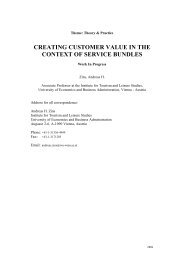amj Australasian Marketing Journal - ANZMAC
amj Australasian Marketing Journal - ANZMAC
amj Australasian Marketing Journal - ANZMAC
Create successful ePaper yourself
Turn your PDF publications into a flip-book with our unique Google optimized e-Paper software.
Prevailing<br />
Acceptable<br />
Legal Regulatory<br />
Framework<br />
try self-regulation; indeed, some researchers have warned that<br />
self-regulation is like letting the lunatics run the asylum<br />
(Ducret, 1991).<br />
Before the advent of self-regulation of any industry, a strong<br />
driving force must be apparent. A knee-jerk reaction from<br />
many industries when faced with the prospect of government<br />
regulation is to opt for self-regulation in an attempt to stave<br />
off what is seen as interference in the marketplace by<br />
government bodies.<br />
In the advertising industry this is often the impetus needed to<br />
establish the foundations for self-regulation of an industry<br />
and, whilst the reasons might be purely enlightened self-interest,<br />
the positive outcome, when compared to a legal alternative,<br />
is a fast, cost-effective system, supported by the industry.<br />
However, where advertising industries opt for self-regulation<br />
of their members conduct and behaviour, they pay the price<br />
of constant scrutiny by interested parties such as government<br />
bodies, consumer groups and social commentators. Many<br />
ASR schemes around the globe, including Australia, have<br />
evolved in this way.<br />
Whilst ASR is an attractive option for advertisers, a pre-requisite<br />
to continued operation and, little direct government<br />
involvement, is the concept of collective action . Collective<br />
action has three main purposes (Harris and Carman, 1984:46);<br />
Community<br />
Self<br />
Compliance<br />
Self-Regulatory<br />
Framework<br />
Standard<br />
Advertising<br />
Figure 1: Acceptable advertising; a framework for analysis<br />
Source: Harker, 1998<br />
Advertising Self-Regulation<br />
first to realise economies of scale in production, second to<br />
internalise the benefits of productive actions and, finally, to<br />
change the balance of power between participants in the<br />
exchange process. However, when focusing on the marketing<br />
exchange process, and in particular the activity of advertising,<br />
unless the vast majority of advertisers are committed to, and<br />
involved in, the ASR scheme, continued self-regulation will<br />
be short-lived.<br />
Gupta and Lad (1983) suggested that industry self-regulation<br />
will only take place if the firms in the industry, the advertisers,<br />
decide to cooperate with each other. Similarly, where the<br />
ASR scheme incorporates a national tripartite system<br />
(Boddewyn, 1992; Sinclair 1992) and the advertisers, agencies<br />
and media are involved in the process, cooperation will<br />
be significantly enhanced. This collective action, which<br />
grows out of the need to regulate, succeeds in spreading the<br />
decision-making responsibility across a group. Although<br />
group decision-making has received a number of criticisms<br />
over the years (wasting of time, evading individual responsibility,<br />
producing conformity and compromise [Ofner, 1959]),<br />
the benefits of quality and acceptance of group decisions still<br />
prevail (Jewell and Reitz, 1981).<br />
3. Acceptable Advertising - The Key Variables<br />
The literature in the area suggests a conceptual framework of<br />
<strong>Australasian</strong> <strong>Marketing</strong> <strong>Journal</strong> 9 (1), 2001 9


